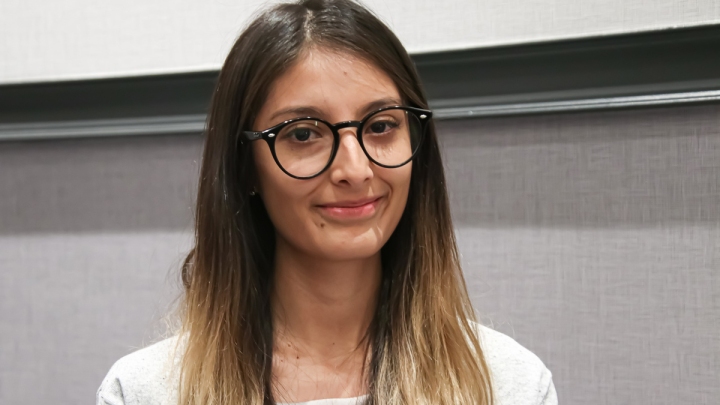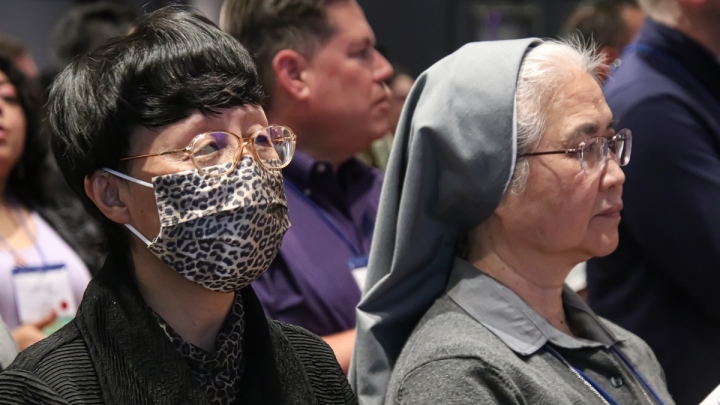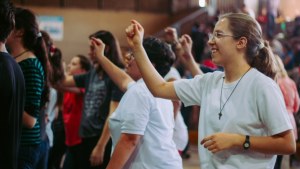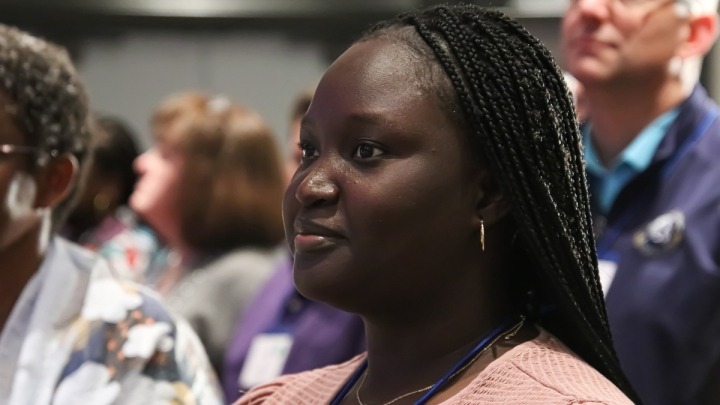Coming into contact with young people of other ethnic groups who suffer the same, and experiencing how Jesus does not reject anyone because of the color of their skin is one of the keys to youth ministry in the USA. Journeying Together, the event that brought together leading Catholic youth leaders from six different cultural and ethnic families on American soil, was a success in this regard
Hispanic-American, Native American, African-American, Anglo-American, Asian and refugee young Catholics converged in a single space. After two years of virtual work, they were finally able to look each other in the eye, hug each other and shake hands. It was during the meeting traveling together, held in Chicago at the end of June.
During the days of this meeting, the young people of the six cultural families were able to participate in the different activities, eat together and talk regardless of the color of their skin or their origin. His identity, that is, his Catholic faith, for a moment became a single DNA; It even allowed them to share important testimonies of the pain they have experienced when discriminated against or hurt in different environments, moments and historical circumstances.
But, despite the emotional moments where they shared their suffering, the young people were also able to laugh and coexist in a climate of peace and unity; they could walk and live together in a safe place; and where the line to confess had the diversity of the physical features of each cultural family.
The Masses were painted in colors, drawing a multicultural environment where languages were united in a single language: the Word of God in his Gospel of Love.
Aleteia was present there, breathing the atmosphere of celebration and unity, and was able to interview some of the participants and also their organizers.
Spicy Pooch
********************
I am Carolina Pérez, I was born in the city of Chicago, my parents are from the state of Michoacán, I am 27 years old and I am working in university ministry, in a university that has Vincentian spirituality.
-What has it meant for you to be in a Journeying Together again?
When the pandemic just started it was a bit difficult, but it was a nice time to reflect and grow spiritually. A friend sent me the link to attend traveling together, and since then I have thought that this is a very nice space to connect with people from different parts of the country and different ethnicities. It was a blessing to hear their testimonies and to talk about the obstacles and difficult times they have been through. This community has been very supportive and has given a lot of light.
-How does this experience of Journeying Together help in university ministry?
I started Journeying Together before my work in campus ministry, where I have students from different cultures, but most are Hispanic American. So, as I go along, I get to know others. Listening to the testimonies of the young people in this meeting has been important because many of them are the same age as my students, and thus I will be able to understand them better.
-How did you experience this multicultural event?
The testimonies of the natives and the black african american They are the ones that, for me, have stood out, because they are judged for the simple fact of being part of that community, because first they see the color of their skin. Being able to hear his testimony was important.
There are also people who are indigenous and Catholic at the same time, and they are happy to say that this is their identity, and they live it according to their culture. A space like this has been essential for them, and so we know how we can support them, how we can walk together and ask their forgiveness not only with words but also with actions.
********************
Mar Muñoz Visoso, executive director of the Department of Cultural Diversity of the USCCB.
-What is the balance of Journeying Together now that they have met in person?
We are at the culmination of a process in which we have been able to see, discern and judge; And now we come to the moment of action. We have learned to communicate, dialogue and evaluate what we have in our roots and in our values, as well as what we can contribute in our Church, in our culture. We had the process of intercultural dialogue which, at the same time, was led by a cultural family. It has been the opportunity to speak, to listen to what affects them (racism, discrimination), and, after discerning the lessons learned as intercultural communities, to make a plan for action: What to do so that the apostolate is inclusive, that it forms and go out and find them?

Spicy Pooch
Something very beautiful that has been seen, after two years of pandemic and virtual meetings, is that we were able to hug each other and know that we have common goals: we want all groups to have access to education and justice; we want to build a Church where everyone has a place at the table and where everyone’s values are well received and not discarded.
Each one of us has been filled with gifts and talents that we can put at the service of the community. Each and every one of us has dignity as sons and daughters of God.
Aren’t Hispanics the only ones who have suffered from differences in this country?
That’s how it is. Native Americans and Afro-Americans have also suffered and, you do not understand how, in our Church and in history, another human being has been told: “You are worth less.” This process has allowed us to realize that everywhere there have been processes of struggle, of discrimination. But we also have many points in common. Despite everything, what unites us is our faith. We must ask ourselves: What are we doing to endow these young people with the missionary impulse? What do you need to be missionary disciples today?
********************
My name is Esmeralda Peña and I am 25 years old; I was born in Chihuahua, Chihuahua, and I live in Tyler, Texas.
-What has Journeying Together meant to you?
It has been a real encounter with myself, with the people of my community and the people of other communities that truly bring us closer to Christ. Being able to get out of a comfort zone and have an encounter with others allows me to recognize the community in Christ and to know that only then can I have a genuine experience. The Church is all of us, then, Journeying Together It has been a real encounter.
-What have you felt when you see so much cultural diversity in the corridors?
Entering Mass and seeing so many different faces, so much cultural richness of the ethnic groups, made me nostalgic. How beautiful it is that we are one, and that we feel and connect towards the same goal, which is the Triune God.
-How has it been listening to the testimonies of other groups and realizing the persecution and discrimination they suffer?
The different sessions helped me to see the particularity of the suffering of each one of us and, especially, in the parish in which I am, which is mostly Hispanic. I can see that we can heal together and I can recognize their difficulties and be a tool or a bridge to help them and that they can help me.
-What do you take from Journeying Togetherand how are you going to apply it?
A much more open mind; a desire to step completely out of my comfort zone; a beautiful personal experience, but that does not stay with me, but rather helps me and allows me to get out of my narrow path to meet others, places and people, that I had no idea or the need to do so. I take the heart of each person I meet with me and I take with me a lot of motivation to continue working for Christ. Heaven is going to be full of different cultures, colors and traits.
********************
Alejandro Aguilera Titus, member of the Hispanic Affairs Committee of the USCCB and national coordinator of the V Encuentro
-What balance do you make of Journeying Together?
A lot of enthusiasm, in the sense that, for two years, people met via zoom; but being in the body is something else entirely. Young people and adults have been taking more and more prominence and all cultural families are very well represented.
-How has being in one place, but full of cultural diversity, worked?
It’s exciting. Being in the same space is another way of interacting; and the young people who participated were prepared, and the new ones were given orientation, and they were all on the same page. The participation was very good and we had pastoral action sessions where we discerned what actions to take, because this is not the end Journeying Togethercontinues at the local level with a process, with personal and group actions, and with national processes.
In general terms, the experience was very positive, and all the diversity of languages, races and expressions was seen as a gift, as a great wealth.

Spicy Pooch
-What realities could be discovered?
The interaction in Journeying Together It was very cross-cultural. For example, pastoral action groups are very diverse; all the families were represented and they spoke of difficult realities, but also of dreams, of the changes they would like to see in the Church or of the changes they really want to make. It was a deep listening process.
Hispanics were able to express our suffering, dreams and hopes, but we also listened and learned from others, and that makes us more aware of and in solidarity with others.
-What commitments do you have?
The pastoral action process that has been developed is based on identifying; For example, in the area of formation: What do you want to see in the Church in the future? How can it be achieved? What are you going to do to make it happen? The “what are you going to do” was analyzed at a personal level and at the level of groups that have a geographical connection so that there is proximity. Projects with a national dimension were also proposed.


